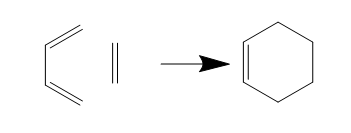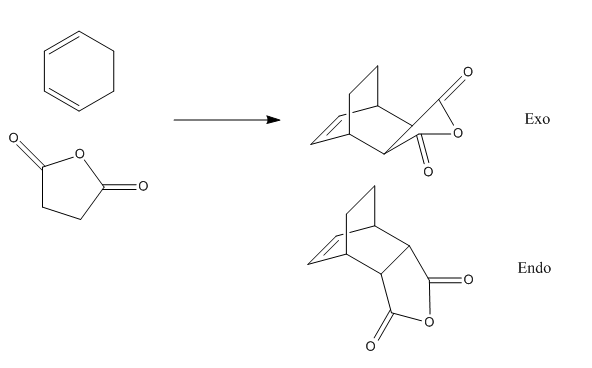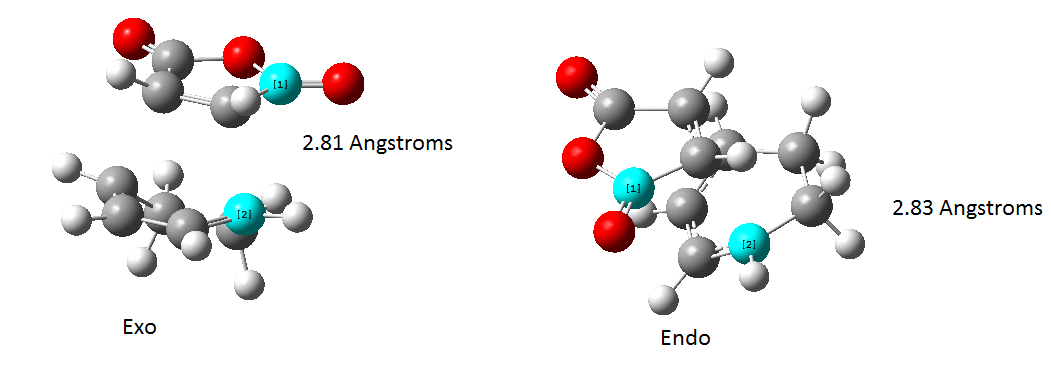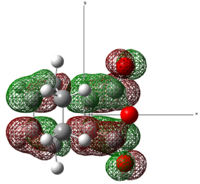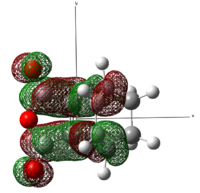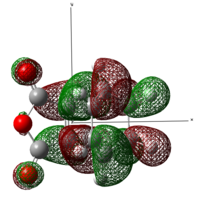Rep:Mod:goodDielsonline
The Diels Alder Cycloaddition
Here, the methods used previously will be applied to Diels Alder reactions. Diels Alder reactions are pericyclic and are concerted. A dieneophile interact with a diene to form σ bonds from pi bonds. The interaction of the HOMO/LUMO of the interacting species depends if the reaction is allowed or forbidden. If the HOMO of one species can interact with the LUMO of the other, the reaction is allowed. There must be significant overlap and the same symmetry. If there are substituents with π orbitals that are of the correct symmetry to interact with the π orbitals, then this can favour a particular position of attack.
Cis-butadiene and Ethylene
To start, the reactants were optimised using the AM1 semi-empirical molecular orbital method. The HOMO and LUMO of both were calculated and are shown. Ethylene is the dieneophile and cis-butadiene is the diene.
| Molecule | Molecular Orbital | Molecular Orbital Diagram | Symmetry | Energy/ Hartrees |
|---|---|---|---|---|
| Cis-butadiene | LUMO | 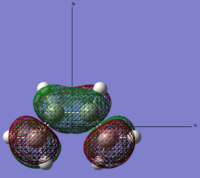 |
Symmetric | 0.01796 |
| Link to file: Media:danCISBUTADIENE-OPT.LOG | HOMO | 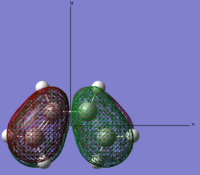 |
Anti-symmetric | -0.34455 |
| Ethylene | LUMO | 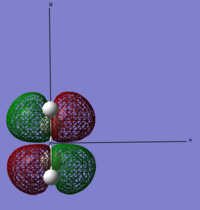 |
Anti-symmetric | 0.05284 |
| Link to file: Media:danETHYLENE.LOG | HOMO | 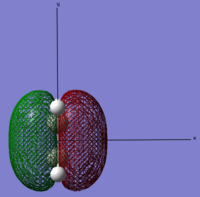 |
Symmetric | -0.38777 |
Looking at the symmetry on the MO’s we can see that the LUMO of cis-butadiene can interact with the HOMO ethylene. Therefore, this reaction is allowed. The other set of HOMO and LUMO also match but these are not π orbitals.
I calculated the transition state using the ‘Frozen coordinate’ method used earlier with the AM1 semi-empirical molecular orbital method, then this I optimised this to a higher accuracy using the B3LYP/6-31G and the following information was produced.
| Diagram | |||
| Energy/ Hartrees | -234.495 | ||
| Link to file | Media:TRANSDIELSALDER1-FROZEN-6-31GDAN.LOG | ||
| Imaginary Frequency/ cm-1 | -534 | ||
| Imaginary Frequency Diagram | 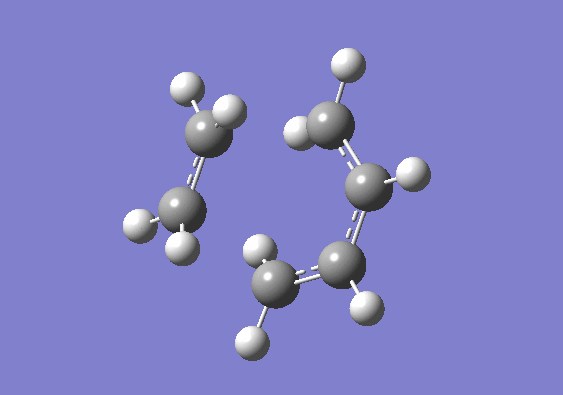
| ||
| Real Frequency Diagram | 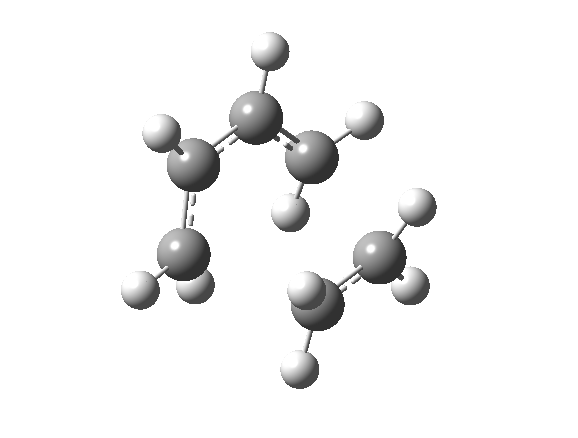
| ||
| Real Frequency/ cm-1 | 140 | ||
| C-C bond lengths between terminal Carbons/ Å | 2.26 | ||
| C-C bond lengths between carbons on ethylene/ Å | 1.39 | ||
| C-C bond lengths between terminal carbons on cis-butadiene/ Å | 1.39 | ||
| C sp3 - C sp3 literature value/ Å [1] [2] | 1.54 | ||
| C sp3 - C sp2 literature value/ Å [1] [2] | 1.50 | ||
| C sp2 - C sp2 literature value/ Å [1] [2] | 1.47 |
The imaginary frequency clearly shows the concerted formation of the bonds(synchronous), however, the lowest real frequency shows that the bond formation is asynchronous. The bond lengths of each fragment are shorter than the literature values, suggesting a higher bond order. The terminal carbon distance is longer than a C-C bond, however, the vibrations bring the carbons closer so orbital overlap becomes efficient, forming the bond.
Let’s examine the HOMO and LUMO.
| Molecule | Molecular Orbital | Molecular Orbital Diagram | Symmetry | Energy/ Hartrees |
|---|---|---|---|---|
| Transition State | LUMO | 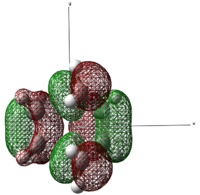 |
Symmetric | 0.02315 |
| HOMO | 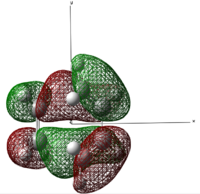 |
Anti-symmetric | -0.32394 |
The HOMO of the transition state is formed from the HOMO of cis-butadiene and the LUMO of ethylene. The symmetry is retained and shows the formation of the new C-C σ bonds. The LUMO is formed from the LUMO of cis-butadiene and the HOMO of ethylene and again, the symmetry is retained and this represents the new C-C σ* orbitals since it has a larger number of nodes.
Cyclohexa-1,3-diene and Maleic Anhydride
This reaction has two possible products and here we will discuss the region selectivity. The C=O bond has π orbitals which can interact to stabilise a particular transition state. This will be shown by analysing the two possible transition states. The transition states were found using the ‘frozen coordinate’ method with the semi-empirical/AM1 method.
| Exo-Transition State | Endo-Transition State | |||||
| Diagram | ||||||
| Energy/ Hartrees | -0.0505 | -0.0516 | ||||
| Link to file | Media:MALEIC-EXO-FROZENdan.LOG | Media:MALEIC-ENDO-FROZENdan.LOG | ||||
| Imaginary Frequency/ cm-1 | -811 | -806 | ||||
| Imaginary Diagram | 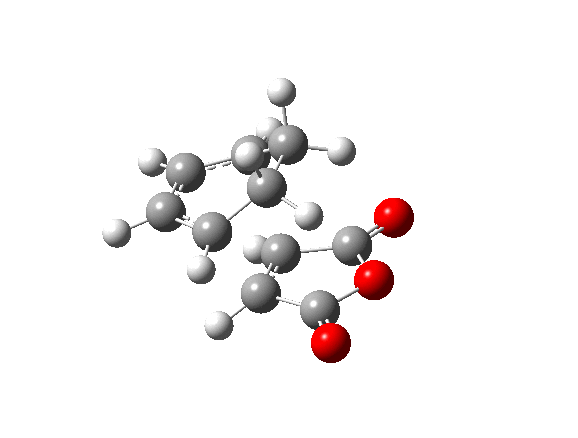 |
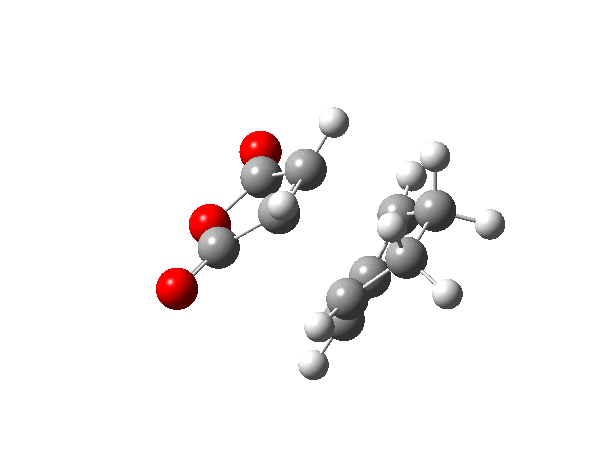
|
Again, the imaginary frequencies show the concerted bond formation nicely. We can see that the endo transition state has a lower energy than the exo transition state. If we draw the Frontier Orbitals, we can see that the endo transition state has some interaction from the C=O п orbitals, which stabilise the transition state, hence lowering its energy.
However, if we look at the strain on the transition states, the opposite is implied as the C=O are closer to the ring.
References

